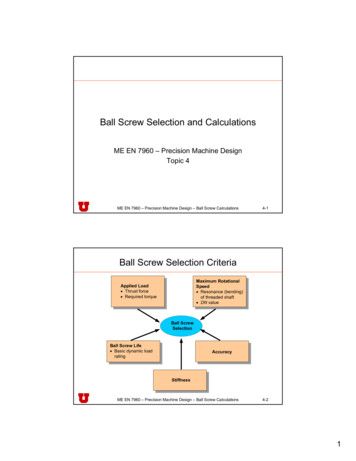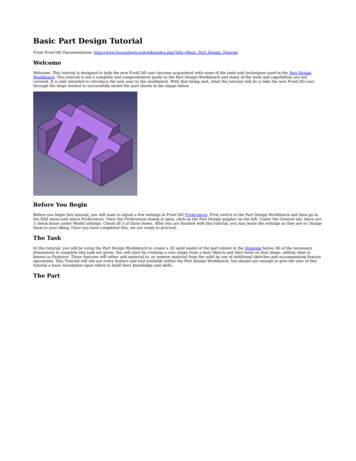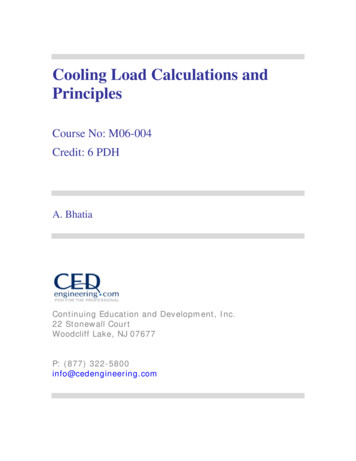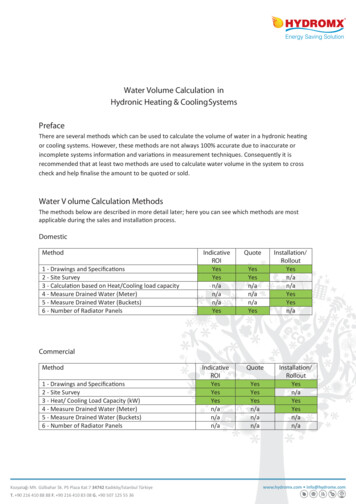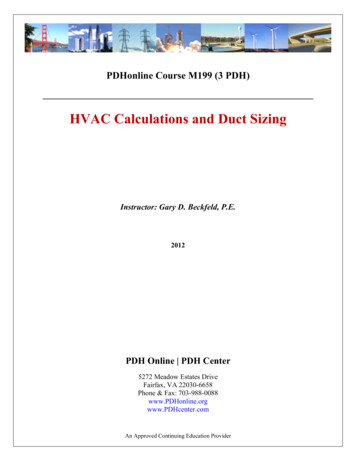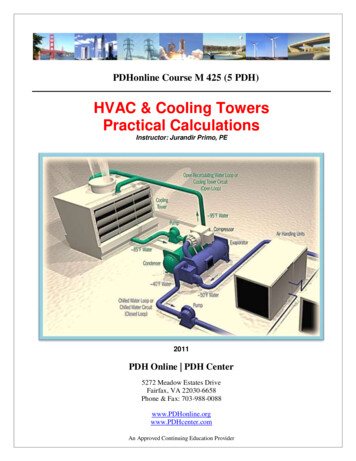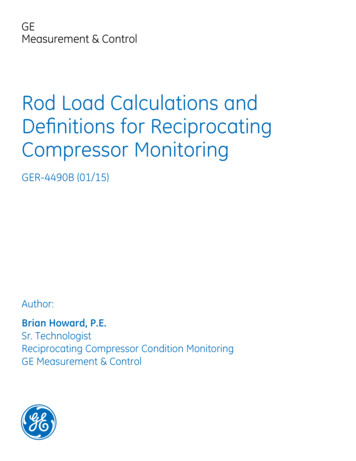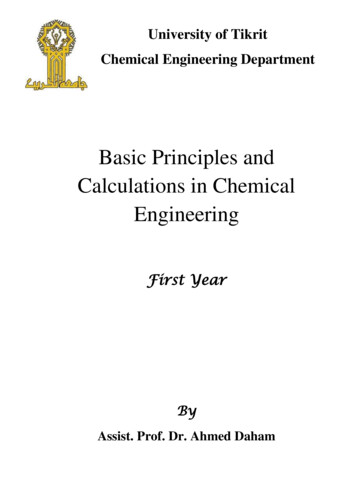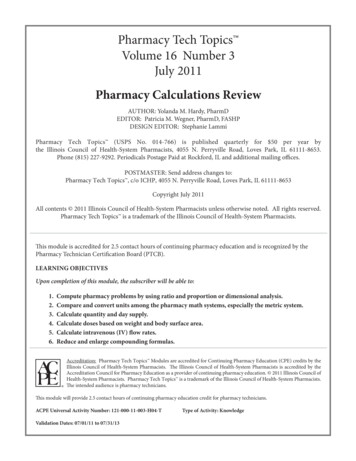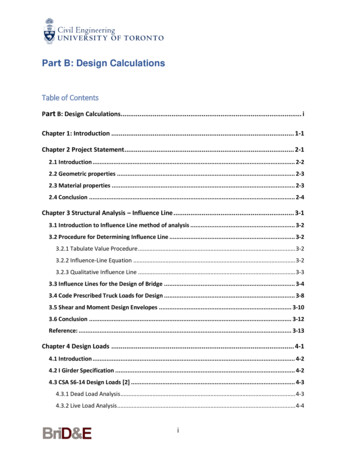
Transcription
Part B: Design CalculationsTable of ContentsPart B: Design Calculations. iChapter 1: Introduction . 1-1Chapter 2 Project Statement . 2-12.1 Introduction . 2-22.2 Geometric properties . 2-32.3 Material properties . 2-32.4 Conclusion . 2-4Chapter 3 Structural Analysis – Influence Line . 3-13.1 Introduction to Influence Line method of analysis . 3-23.2 Procedure for Determining Influence Line . 3-23.2.1 Tabulate Value Procedure . 3-23.2.2 Influence-Line Equation . 3-23.2.3 Qualitative Influence Line . 3-33.3 Influence Lines for the Design of Bridge . 3-43.4 Code Prescribed Truck Loads for Design . 3-83.5 Shear and Moment Design Envelopes . 3-103.6 Conclusion . 3-12Reference: . 3-13Chapter 4 Design Loads . 4-14.1 Introduction . 4-24.2 I Girder Specification . 4-24.3 CSA S6-14 Design Loads [2] . 4-34.3.1 Dead Load Analysis . 4-34.3.2 Live Load Analysis . 4-4i
4.3.3 Load Combinations. 4-64.4 AASHTO LRFD 2012 Design Loads [3] . 4-74.4.1 Dead Load Analysis . 4-74.4.2 Live Load . 4-84.4.3 Load Combinations. 4-124.5 CSA S6-66 Design Loads [4] . 4-134.5.1 Dead Loads . 4-134.5.2 Determination of Live Loads . 4-144.5.3 Determination of Total Design Loads . 4-174.6 Summary of Design Loads . 4-184.7 Conclusion . 4-18Reference: . 4-19Chapter 5 Design of Prestressed Concrete Girder . 5-15.1 Introduction . 5-35.2 Cross-Section Geometry . 5-35.3 CSA S6-14 [2] . 5-45.3.1 Prestressing Design . 5-45.3.2 Choose the Tendon Profile . 5-55.3.3 Check the Concrete Stresses at Service Load . 5-55.3.4 Check the Flexural Capacity . 5-75.3.5 Check the Reserve Strength after Cracking. 5-75.3.6 Check the Deflections. 5-85.3.7 Design for Shear Reinforcement . 5-95.3.8 Design for Shrinkage and Temperature Reinforcement . 5-115.4 AASHTO LRFD-14 [3] . 5-125.4.1 Prestressing Design . 5-125.4.2 Choose the Tendon Profile . 5-135.4.3 Check the Concrete Stresses at Service Load . 5-145.4.4 Check the Flexural Capacity . 5-165.4.5 Check the Reserve Strength after Cracking . 5-175.4.6 Check the Deflections. 5-17ii
5.4.7 Design for Shear Reinforcement . 5-195.4.8 Design for Shrinkage and Temperature Reinforcement . 5-215.5 CSA S6-66 [4] . 5-225.5.1 Prestressing Design . 5-225.5.2 Choose the Tendon Profile. 5-235.5.3 Check the Concrete Stresses at Service Load . 5-245.5.4 Check the Flexural Capacity . 5-255.5.5 Check the Deflections. 5-265.5.6 Design for Shear Reinforcement . 5-265.5.7 Design for Shrinkage and Temperature Reinforcement . 5-285.6 Summary . 5-29Reference: . 5-30Chapter 6 Reinforced Concrete Deck Design. 6-16.1 Introduction . 6-26.2 CSA S6-14 [1] . 6-26.2.1 Design Input . 6-26.2.2 Design Loads. 6-36.2.3 Factored Design Moments . 6-46.2.4 Negative Transverse Moment Flexure Design . 6-56.2.5 Positive Transverse Moment Flexure Design . 6-66.2.6 Bottom Distribution Reinforcement . 6-76.2.7 Top of Slab Shrinkage and Temperature Reinforcement . 6-86.3 ASSHTO LRFD-14 [2] . 6-86.3.1 Design Input . 6-86.3.2 Dead Loads . 6-96.3.3 Live Loads . 6-96.3.4 Factored Design Moment. 6-106.3.5 Flexural Design at Midspan . 6-106.3.6 Flexural Design at Support . 6-116.3.7 Bottom Reinforcement Perpendicular Direction . 6-126.3.8 Shrinkage and Temperature Reinforcement. 6-12iii
6.4 CSA S6-66 [3] . 6-136.4.1 Design Input . 6-136.4.2 Dead Load Effects . 6-136.4.3 Live Loads . 6-146.4.4 Factored Design Moments . 6-156.4.5 Negative Transverse Moment Flexure Design . 6-156.4.6 Positive Transverse Moment Flexure Design . 6-166.4.7 Bottom Distribution Reinforcement . 6-176.4.8 Top of Slab Shrinkage and Temperature Reinforcement . 6-186.5 Conclusion . 6-19Reference: . 6-20Chapter 7 Durability Design . 7-17.1 Introduction . 7-27.2 Concrete Exposure Condition . 7-27.3 Strength . 7-27.4 Water-Cement Ratio. 7-37.5 Air Content. 7-47.6 Slump . 7-47.7 Water Content . 7-57.8 Cement Content . 7-67.9 Coarse Aggregate Content . 7-
design of bridges, industrial crane rails, conveyors, and other structures where loads move across their span because the influence line enables direct measure of where the moving load should be placed on the structure to create the greatest influence at the specified location. In addition, the magnitude of the associated reaction, shear, moment, or deflection at the specified location can be .

